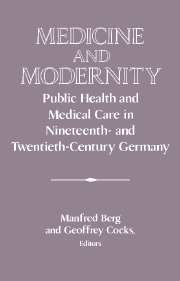Book contents
- Frontmatter
- Introduction
- 1 To Benefit the Poor and Advance Medical Science: Hospitals and Hospital Care in Germany, 1820-1870
- 2 From Traditional Individualism to Collective Professionalism: State, Patient, Compulsory Health Insurance, and the Panel Doctor Question in Germany, 1883—1931
- 3 In Search of German Social Darwinism: The History and Historiography of a Concept
- 4 Modern German Doctors: A Failure of Professionalization?
- 5 The Mentally Ill Patient Caught between the State's Demands and the Professional Interests of Psychiatrists
- 6 Rationalizing the Therapeutic Arsenal: German Neuropsychiatry in World War I
- 7 Sterilization and “Medical” Massacres in National Socialist Germany: Ethics, Politics, and the Law
- 8 The Old as New: The Nuremberg Doctors' Trial and Medicine in Modern Germany
- 9 The Debate that Will Not End: The Politics of Abortion in Germany from Weimar to National Socialism and the Postwar Period
- 10 The Sewering Scandal of 1993 and the German Medical Establishment
- Index
8 - The Old as New: The Nuremberg Doctors' Trial and Medicine in Modern Germany
Published online by Cambridge University Press: 05 January 2013
- Frontmatter
- Introduction
- 1 To Benefit the Poor and Advance Medical Science: Hospitals and Hospital Care in Germany, 1820-1870
- 2 From Traditional Individualism to Collective Professionalism: State, Patient, Compulsory Health Insurance, and the Panel Doctor Question in Germany, 1883—1931
- 3 In Search of German Social Darwinism: The History and Historiography of a Concept
- 4 Modern German Doctors: A Failure of Professionalization?
- 5 The Mentally Ill Patient Caught between the State's Demands and the Professional Interests of Psychiatrists
- 6 Rationalizing the Therapeutic Arsenal: German Neuropsychiatry in World War I
- 7 Sterilization and “Medical” Massacres in National Socialist Germany: Ethics, Politics, and the Law
- 8 The Old as New: The Nuremberg Doctors' Trial and Medicine in Modern Germany
- 9 The Debate that Will Not End: The Politics of Abortion in Germany from Weimar to National Socialism and the Postwar Period
- 10 The Sewering Scandal of 1993 and the German Medical Establishment
- Index
Summary
On October 25, 1946, Brigadier General Telford Taylor, Chief of Counsel for War Crimes, filed an indictment before Nuremberg Military Tribunal I charging twenty-three German defendants with “murders, brutalities, cruelties, tortures, atrocities, and other inhumane acts.” Known officially as “The Medical Case,” the subsequent proceedings also became known as “The Doctors' Trial” because twenty of the defendants were physicians. On August 20, 1947, fifteen of the defendants were declared guilty. The next day seven were sentenced to death and five to life imprisonment. The charges encompassed four crimes: the Jewish skeleton collection, the project to kill tubercular Polish nationals, the “euthanasia” program, and medical experiments on civilian and military prisoners. The experiments included the following: high altitude; freezing; malaria; mustard gas; sulfanilamide treatment of gas gangrene; bone, muscle, and nerve regeneration and bone transplantation; potability of sea water; epidemic jaundice, typhus, and other vaccines; poisoned food and bullets; phosphorus incendiary bombs; biochemical treatment of sepsis with phlegmon; blood coagulation with polygal; toxicity of phenol; chemical, surgical, and X-ray sterilization. The victims included Germans, Russians, Czechs, Ukrainians, Poles, Yugoslavs, Jews, Roma, Jehovah's Witnesses, communists, theologians, resistance fighters, mental patients, so-called asocials, men, women, and children. The exact numbers are impossible to determine, but according to trial documents, approximately 3,500 people were used as test subjects. At least 800 died, as many as 400 of the 1,100 test subjects in the Dachau malaria tests alone.
- Type
- Chapter
- Information
- Medicine and ModernityPublic Health and Medical Care in Nineteenth- and Twentieth-Century Germany, pp. 173 - 192Publisher: Cambridge University PressPrint publication year: 1997
- 2
- Cited by



